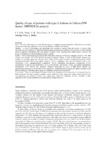Mostrar o rexistro simple do ítem
Quality of care of patients with type-2 diabetes in Galicia (NW Spain) [OBTEDIGA project]
| dc.contributor.author | Vidal-Pardo, J.I. | |
| dc.contributor.author | Pérez-Castro, Teresa-Rosalía | |
| dc.contributor.author | López Álvarez, X.L. | |
| dc.contributor.author | García-Soidán, J.L. | |
| dc.contributor.author | Santiago-Pérez, M.I. | |
| dc.contributor.author | Muñiz, Javier | |
| dc.date.accessioned | 2015-09-02T09:21:19Z | |
| dc.date.available | 2015-09-02T09:21:19Z | |
| dc.date.issued | 2011-08-01 | |
| dc.identifier.citation | Vidal Pardo JI, Pérez Castro TR, López Álvarez XL, García Soidán FJ, Santiago Pérez MI, Muñiz J. Quality of care of patients with type-2 diabetes in Galicia (NW Spain) [OBTEDIGA project]. Int J Clin Pract. 2011;65(10):1067-1075 | es_ES |
| dc.identifier.uri | http://hdl.handle.net/2183/14896 | |
| dc.description.abstract | [Abstract] Aims: The aim of this study was to describe the degree of compliance of agreed practices with reference to primary care patients with Type 2 diabetes of 40 years old and older in Galicia (NW Spain). Methods: A total of 108 primary care physicians were selected at random from the totality of doctors. Each physician selected 30 patients at random from their patients suffering from diabetes of 40 years old or older. External observers gathered information from each patient’s medical record regarding their characteristics, condition and degree of compliance of selected indicators of good practice. Results: Group of physicians participated in this study had a mean age of 50 years (standard deviation = 3.9); 48% of them were females; and 17.5% involved in medical residents training. A total of 3078 diabetic patients were included in the study: mean age = 69 years (SD = 10.9), 47.6% women, presence of high blood pressure (72%), hypercholesterolaemia (56%), and regular smokers (10.3%). Compliance with selected indicators such as foot examination (14%), ophthalmological examination (30.6%), abdominal circumference measurement (6.1%), measurement of total or LDL-cholesterol (78.1), blood pressure measurement (84.8), glycosylated haemoglobin measurement < 7% (54.3%) was observed. Adequate monitoring in cases of high blood pressure and hypercholesterolaemia were 34.2% and 27.4%, respectively. Variability between physicians differs according to the different indicators, with interquartile range for compliance of between 16.4 and 66%. Conclusions: There is a wide margin for improvement in the adaptation of clinical practice to recommendations for diabetic patients. The large variation existing in certain indicators would suggest that certain control objectives are less demanding than advisable in those that comply least, while low compliance and low variability in other indicators point to structural problems or unsatisfactory training of doctors. | es_ES |
| dc.language.iso | eng | es_ES |
| dc.publisher | Wiley | es_ES |
| dc.relation.uri | http://dx.doi.org/10.1111/j.1742-1241.2011.02739.x | es_ES |
| dc.rights | This is the peer reviewed version of the article which has been published in final form at Wiley Online Library. This article may be used for non-commercial purposes in accordance with Wiley Terms and Conditions for self-archiving. | es_ES |
| dc.title | Quality of care of patients with type-2 diabetes in Galicia (NW Spain) [OBTEDIGA project] | es_ES |
| dc.type | info:eu-repo/semantics/article | es_ES |
| dc.rights.access | info:eu-repo/semantics/openAccess | es_ES |
Ficheiros no ítem
Este ítem aparece na(s) seguinte(s) colección(s)
-
GI- GRINCAR - Artigos [226]






